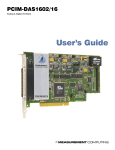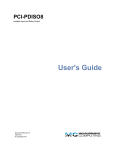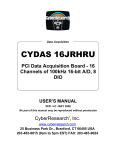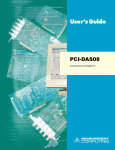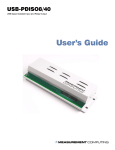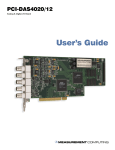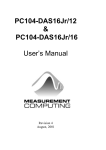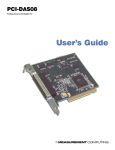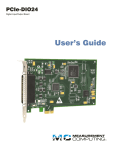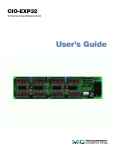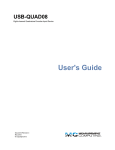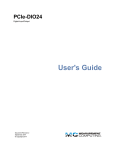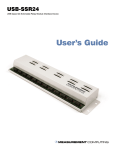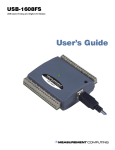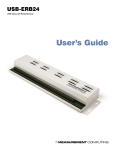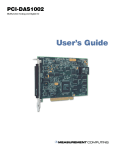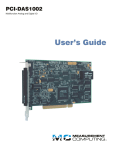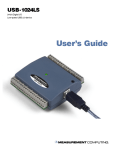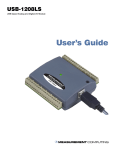Download PCIM-DAS16JR/16 User`s Guide
Transcript
PCIM-DAS16JR/16 Analog & Digital I/O Board User's Guide Document Revision 3, May, 2006 © Copyright 2006, Measurement Computing Corporation Your new Measurement Computing product comes with a fantastic extra — Management committed to your satisfaction! Refer to www.mccdaq.com/execteam.html for the names, titles, and contact information of each key executive at Measurement Computing. Thank you for choosing a Measurement Computing product—and congratulations! You own the finest, and you can now enjoy the protection of the most comprehensive warranties and unmatched phone tech support. It’s the embodiment of our two missions: ! To offer the highest-quality, computer-based data acquisition, control, and GPIB hardware and software available—at the best possible price. ! To offer our customers superior post-sale support—FREE. Whether providing unrivaled telephone technical and sales support on our latest product offerings, or continuing that same first-rate support on older products and operating systems, we’re committed to you! Lifetime warranty: Every hardware product manufactured by Measurement Computing Corporation is warranted against defects in materials or workmanship for the life of the product. Products found defective are repaired or replaced promptly. Lifetime Harsh Environment Warranty®: We will replace any product manufactured by Measurement Computing Corporation that is damaged (even due to misuse) for only 50% of the current list price. I/O boards face some tough operating conditionssome more severe than the boards are designed to withstand. When a board becomes damaged, just return the unit with an order for its replacement at only 50% of the current list price. We don’t need to profit from your misfortune. By the way, we honor this warranty for any manufacturer’s board that we have a replacement for. 30 Day Money Back Guarantee: You may return any Measurement Computing Corporation product within 30 days of purchase for a full refund of the price paid for the product being returned. If you are not satisfied, or chose the wrong product by mistake, you do not have to keep it. Please call for an RMA number first. No credits or returns accepted without a copy of the original invoice. Some software products are subject to a repackaging fee. These warranties are in lieu of all other warranties, expressed or implied, including any implied warranty of merchantability or fitness for a particular application. The remedies provided herein are the buyer’s sole and exclusive remedies. Neither Measurement Computing Corporation, nor its employees shall be liable for any direct or indirect, special, incidental or consequential damage arising from the use of its products, even if Measurement Computing Corporation has been notified in advance of the possibility of such damages. HM PCIM-DAS16jr_16.doc ii Trademark and Copyright Information TracerDAQ, Universal Library, InstaCal, Harsh Environment Warranty, Measurement Computing Corporation, and the Measurement Computing logo are either trademarks or registered trademarks of Measurement Computing Corporation. Windows, Microsoft, and Visual Studio are either trademarks or registered trademarks of Microsoft Corporation LabVIEW is a trademark of National Instruments. CompactFlash is a registered trademark of SanDisk Corporation. All other trademarks are the property of their respective owners. Information furnished by Measurement Computing Corporation is believed to be accurate and reliable. However, no responsibility is assumed by Measurement Computing Corporation neither for its use; nor for any infringements of patents or other rights of third parties, which may result from its use. No license is granted by implication or otherwise under any patent or copyrights of Measurement Computing Corporation. All rights reserved. No part of this publication may be reproduced, stored in a retrieval system, or transmitted, in any form by any means, electronic, mechanical, by photocopying, recording, or otherwise without the prior written permission of Measurement Computing Corporation. Notice Measurement Computing Corporation does not authorize any Measurement Computing Corporation product for use in life support systems and/or devices without prior written consent from Measurement Computing Corporation. Life support devices/systems are devices or systems which, a) are intended for surgical implantation into the body, or b) support or sustain life and whose failure to perform can be reasonably expected to result in injury. Measurement Computing Corporation products are not designed with the components required, and are not subject to the testing required to ensure a level of reliability suitable for the treatment and diagnosis of people. iii Table of Contents Preface About this User's Guide ......................................................................................................................vi What you will learn from this user's guide ........................................................................................................vi Conventions in this user's guide....................................................................................................................................... vi Where to find more information ........................................................................................................................vi Chapter 1 Introducing the PCIM-DAS16JR/16 ................................................................................................. 1-1 Overview: PCIM-DAS16JR/16 features ........................................................................................................ 1-1 Software features ............................................................................................................................................ 1-1 Chapter 2 Installing the PCIM-DAS16JR/16 ..................................................................................................... 2-1 What comes with your PCIM-DAS16JR/16 shipment? ................................................................................. 2-1 Hardware ....................................................................................................................................................................... 2-1 Additional documentation.............................................................................................................................................. 2-1 Optional components ..................................................................................................................................................... 2-2 Unpacking the PCIM-DAS16JR/16................................................................................................................ 2-2 Installing the software .................................................................................................................................... 2-2 Default hardware configuration...................................................................................................................... 2-2 Channel mode switch..................................................................................................................................................... 2-3 A/D trigger edge jumper ................................................................................................................................................ 2-4 Clock frequency jumper................................................................................................................................................. 2-4 Installing the PCIM-DAS16JR/16 .................................................................................................................. 2-5 Connecting the board for I/O operations ........................................................................................................ 2-5 Connectors, cables – main I/O connector....................................................................................................................... 2-5 Pin out – main I/O connector ......................................................................................................................................... 2-6 Cabling........................................................................................................................................................................... 2-6 Field wiring, signal termination, and signal conditioning .............................................................................................. 2-7 Chapter 3 Programming and Developing Applications .................................................................................. 3-1 Programming languages ................................................................................................................................. 3-1 Packaged applications programs..................................................................................................................... 3-1 Register-level programming ........................................................................................................................... 3-1 Chapter 4 Functional Details ............................................................................................................................. 4-1 Analog inputs.................................................................................................................................................. 4-2 Burst mode..................................................................................................................................................................... 4-2 Digital I/O....................................................................................................................................................... 4-3 Counter/timer I/O ........................................................................................................................................... 4-3 Chapter 5 Calibrating the PCIM-DAS16JR/16 .................................................................................................. 5-1 Calibrating the A/D & D/A converters ........................................................................................................... 5-1 Required equipment ....................................................................................................................................................... 5-1 Chapter 6 Specifications.................................................................................................................................... 6-1 Power consumption ........................................................................................................................................ 6-1 Analog input ................................................................................................................................................... 6-1 iv PCIM-DAS16JR/16 User's Guide Accuracy ........................................................................................................................................................................ 6-2 Analog input drift........................................................................................................................................................... 6-2 Noise performance......................................................................................................................................................... 6-2 Settling time................................................................................................................................................................... 6-3 Digital input / output....................................................................................................................................... 6-3 Main connector .............................................................................................................................................................. 6-3 Counter ........................................................................................................................................................... 6-4 Environmental ................................................................................................................................................ 6-4 Mechanical ..................................................................................................................................................... 6-4 Main connector and pin out ............................................................................................................................ 6-4 8-channel differential mode pin out ............................................................................................................................... 6-5 16-channel single-ended mode pin out........................................................................................................................... 6-5 v Preface About this User's Guide What you will learn from this user's guide This user's guide explains how to install, configure, and use the PCIM-DAS16JR/16 so that you get the most out of its analog, digital, and counter I/O features. This user's guide also refers you to related documents available on our web site, and to technical support resources. Conventions in this user's guide For more information on … Text presented in a box signifies additional information and helpful hints related to the subject matter you are reading. Caution! Shaded caution statements present information to help you avoid injuring yourself and others, damaging your hardware, or losing your data. <#:#> Angle brackets that enclose numbers separated by a colon signify a range of numbers, such as those assigned to registers, bit settings, etc. bold text Bold text is used for the names of objects on the screen, such as buttons, text boxes, and check boxes. For example: 1. Insert the disk or CD and click the OK button. italic text Italic text is used for the names of manuals and help topic titles, and to emphasize a word or phrase. For example: The InstaCal® installation procedure is explained in the Quick Start Guide. Never touch the exposed pins or circuit connections on the board. Where to find more information The following electronic documents provide information that can help you get the most out of your PCIMDAS16JR/16 hardware. ! ! ! ! ! ! MCC's Specifications: PCIM-DAS16JR/16 (the PDF version of the Electrical Specification Chapter in this guide) is available on our web site at www.mccdaq.com/pdfs/PCIM-DAS16Jr-16.pdf. MCC's Quick Start Guide is available on our web site at www.mccdaq.com/PDFmanuals/DAQ-Software-Quick-Start.pdf. MCC's Guide to Signal Connections is available on our web site at www.mccdaq.com/signals/signals.pdf. MCC's Universal Library User's Guide is available on our web site at www.mccdaq.com/PDFmanuals/sm-ul-user-guide.pdf. MCC's Universal Library Function Reference is available on our web site at www.mccdaq.com/PDFmanuals/sm-ul-functions.pdf. MCC's Universal Library for LabVIEW™ User’s Guide is available on our web site at www.mccdaq.com/PDFmanuals/SM-UL-LabVIEW.pdf. PCIM-DAS16JR/16 User's Guide (this document) is also available on our web site at www.mccdaq.com/PDFmanuals/PCIM-DAS16Jr-16.pdf. vi Chapter 1 Introducing the PCIM-DAS16JR/16 Overview: PCIM-DAS16JR/16 features This manual explains how to install and use the PCIM-DAS16JR/16 board. The PCIM-DAS16JR/16 is a multifunction measurement and control board designed to operate in computers with PCI accessory slots. This board can be used for applications such as data acquisition, system timing, and industrial process control. The PCIM-DAS16JR/16 provides the following features: ! ! ! ! ! ! ! Eight differential or 16 single-ended analog inputs 16-bit A/D resolution 100 kHz sample rate Eight TTL-compatible digital I/O channels Three 16-bit down counters 37-pin high density I/O connector Universal PCI bus (3.3V/5V 32-bit 33 MHz) The analog input mode is switch-selectable for eight differential or 16 single-ended analog inputs. Analog input ranges are selectable with software as bipolar or unipolar. Bipolar input ranges are ±10V, ±5V, ±2.5V and ±1.25V. Unipolar input ranges are 0 to 10V, 0 to 5V, 0 to 2.5V and 0 to 1.25V. The PCIM-DAS16JR/16 board is equipped with an 82C54 counter chip. This chip contains three 16-bit down counters that provide clock, gate, and output connections. Software features For information on the features of InstaCal and the other software included with your PCIM-DAS16JR/16, refer to the Quick Start Guide that shipped with your device. The Quick Start Guide is also available in PDF at www.mccdaq.com/PDFmanuals/DAQ-Software-Quick-Start.pdf. Check www.mccdaq.com/download.htm for the latest software version or versions of the software supported under less commonly used operating systems. 1-1 Chapter 2 Installing the PCIM-DAS16JR/16 What comes with your PCIM-DAS16JR/16 shipment? The following items are shipped with the PCIM-DAS16JR/16. Hardware ! PCIM-DAS16JR/16 Additional documentation In addition to this hardware user's guide, you should also receive the Quick Start Guide (available in PDF at www.mccdaq.com/PDFmanuals/DAQ-Software-Quick-Start.pdf). This booklet supplies a brief description of the software you received with your PCIM-DAS16JR/16 and information regarding installation of that software. Please read this booklet completely before installing any software or hardware. 2-1 PCIM-DAS16JR/16 User's Guide Installing the PCIM-DAS16JR/16 Optional components If you ordered any of the following products with your board, they should be included with your shipment. ! Cables C37FF-x ! C37FFS-x Signal termination and conditioning accessories MCC provides signal termination products for use with the PCIM-DAS16JR/16. Refer to the "Field wiring, signal termination and signal conditioning" section on page 2-7 for a complete list of compatible accessory products. Unpacking the PCIM-DAS16JR/16 As with any electronic device, you should take care while handling to avoid damage from static electricity. Before removing the PCIM-DAS1602/16 from its packaging, ground yourself using a wrist strap or by simply touching the computer chassis or other grounded object to eliminate any stored static charge. If any components are missing or damaged, notify Measurement Computing Corporation immediately by phone, fax, or e-mail: ! ! ! Phone: 508-946-5100 and follow the instructions for reaching Tech Support. Fax: 508-946-9500 to the attention of Tech Support Email: [email protected] Installing the software Refer to the Quick Start Guide for instructions on installing the software on the Measurement Computing Data Acquisition Software CD. This booklet is available in PDF at www.mccdaq.com/PDFmanuals/DAQ-SoftwareQuick-Start.pdf. Configuring the PCIM-DAS16JR/16 The PCIM-DAS16JR/16 board has one switch and two jumpers mounted on it. Before installing the PCIMDAS16JR/16 in the computer, verify that the board is configured with the settings that you want. Factory default settings are listed in Table 2-1. Table 2-1. Switch/jumper factory-configured defaults Board label Switch/jumper description Default setting S1 P8 P2 Channel mode switch A/D Trigger edge jumper Clock frequency jumper 8 channel (diff) Rising edge 1 MHz The locations of each switch and jumper are shown in Figure 2-1. 2-2 PCIM-DAS16JR/16 User's Guide Installing the PCIM-DAS16JR/16 A/D trigger edge jumper Channel mode switch Clock frequency jumper Figure 2-1. PCIM-DAS16JR/16 switch and jumper locations Instructions on how to change the configuration of each jumper and switch are shown on the following pages. Channel mode switch Switch S1 configures the analog inputs of the PCIM-DAS16JR/16 as either eight differential channels or 16 single-ended channels. Set the switch to single-ended mode if you have more than eight analog inputs to sample. Setting the switch to differential mode allows up to 10 volts of common mode (ground loop) rejection and provides better noise immunity. The channel mode switch is factory-configured for eight differential inputs (see Figure 2-2.) To configure for 16 single-ended channels, set this switch to "SE". SE DIFF S1 Figure 2-2. Channel mode switch 2-3 PCIM-DAS16JR/16 User's Guide Installing the PCIM-DAS16JR/16 A/D trigger edge jumper Jumper P8 configures the edge to initiate the A/D conversion with. The options are either rising or falling edge. The A/D trigger edge jumper is factory-configured for rising edge. Figure 2-3 shows the jumper position for each configuration option. Rising edge A/D trigger DAS-16 method R Default setting F P8 Falling edge A/D trigger DAS-16 method R F P8 P8 Figure 2-3. A/D trigger edge jumper For compatibility with all third-party packages, DAS-16 software, and PCIM-DAS16JR/16 software, leave this jumper set to the default rising edge position. If you are using the PCIM-DAS16JR/16 board in an application that is designed for compatibility with the Keithley MetraByte DAS-1600 board, configure the trigger edge jumper for falling edge. Clock frequency jumper Jumper P2 configures the frequency of the square wave that is used as a clock by the A/D pacer circuitry. This pacer circuitry controls the sample timing of the A/D. You can configure the frequency for 10 MHz or 1 MHz. The clock frequency jumper is factory-configured for 1 MHz, as shown in Figure 2-4. 10M CLK SEL P2 1M Figure 2-4. Clock frequency jumper Configure this jumper for 10 MHz, unless you have reason to do otherwise. The internal pacer output is also available at pin 20 The internal pacer output that drives the A/D converter is also available at pin 20 (CTR 3 Output) on the board's main I/O connector (see Figure 2-5). 2-4 PCIM-DAS16JR/16 User's Guide Installing the PCIM-DAS16JR/16 Installing the PCIM-DAS16JR/16 After you configure the board's switches and jumpers, install the PCIM-DAS16JR/16 into your computer. To install your board, follow the steps below: Install the MCC DAQ software before you install your board The driver needed to run your board is installed with the MCC DAQ software. Therefore, you need to install the MCC DAQ software before you install your board. Refer to the Quick Start Guide for instructions on installing the software. 1. Turn your computer off, open it up, and insert your board into any available PCI slot. 2. Close your computer and turn it on. If you are using an operating system with support for plug-and-play (such as Windows 2000 or Windows XP), a dialog box pops up as the system loads indicating that new hardware has been detected. If the information file for this board is not already loaded onto your PC, you will be prompted for the disk containing this file. The MCC DAQ software contains this file. If required, insert the Measurement Computing Data Acquisition Software CD and click OK. 3. To test your installation and configure your board, run the InstaCal utility installed in the previous section. Refer to the DAQ Software Quick Start that came with your board for information on how to initially set up and load InstaCal. Board configuration with InstaCal If you change the board configuration with InstaCal, you may have to also physically change the setting of a corresponding switch or jumper on the board. Refer to Default hardware configuration on page 2-2 for specific jumper and switch information. Allow your computer to warm up for at least 15 minutes before acquiring data. The high speed components used on the board generate heat, and it takes this amount of time for a board to reach steady state if it has been powered off for a significant amount of time. Connecting the board for I/O operations Connectors, cables – main I/O connector Table 2-2 lists the board connectors, applicable cables, and compatible accessory products for the PCIMDAS16JR/16. Table 2-2. Board connectors, cables, accessory equipment Connector type Connector compatibility Compatible cables Compatible accessory products (with the C37FF-x cable or C37FFs-x cable) 37 pin male "D" connector Identical to the CIO-DAS16JR/16 connector C37FF-x (Figure 2-6) C37FFS-x (Figure 2-7) CIO-MINI37 SCB-37 CIO-SSH16 The PCIM-DAS16JR/16 board's main I/O connector is a 37-pin "D" connector that is accessible from the rear of the PC on the expansion back plate. This connector accepts female 37-pin D-type connectors, such as the C37FF-x 37-pin cable (Figure 2-6) or the C37FFS-x 37-pin shielded cable (Figure 2-7). Analog connections and configuration General information on analog signal connections and configuration is contained in the Guide to Signal Connections (available on our web site at www.mccdaq.com/signals/signals.pdf). 2-5 PCIM-DAS16JR/16 User's Guide Installing the PCIM-DAS16JR/16 Pin out – main I/O connector CTR 1 Clock In DIG Out 2 DIG Out 0 DIG In 2/CTR1 Gate SS&H Out N/C AGND AGND CH7 High CH6 High CH5 High CH4 High CH3 High CH2 High CH1 High CH0 High 20 21 22 23 24 25 26 27 28 29 30 31 32 33 34 35 36 37 +5V PC Bus Power CTR 1 OUT DIG Out 3 DIG Out 1 DIG In 3 DIG In 1 DIG Gnd N/C N/C N/C Ch7 Low / Ch15 High Ch6 Low / Ch14 High Ch5 Low / Ch13 High Ch4 Low / Ch12 High Ch3 Low / Ch11 High Ch2 Low / Ch10 High Ch1 Low / Ch9 High Ch0 Low / Ch8 High AGND PCI Slot Figure 2-5. Main I/O connector Cabling You can use the C37FF-x or C37FFS-x 37-pin cable to connect signals to the PCIM-DAS16JR/16 board. The red stripe identifies pin # 1 1 1 20 20 37 37 19 19 Figure 2-6. C37FF-x cable 1 19 1 20 37 19 Figure 2-7. C37FFS-x cable 2-6 20 37 PCIM-DAS16JR/16 User's Guide Installing the PCIM-DAS16JR/16 Field wiring, signal termination, and signal conditioning You can use the following MCC screw terminal boards to terminate field signals and route them into the PCIMDAS16JR/16 board using a C37FF-x cable or a C37FFS-x cable: ! ! CIO-MINI37 – 4 x 4, 37-pin screw terminal board. Details on this product are available at www.mccdaq.com/cbicatalog/cbiproduct.asp?dept_id=102&pf_id=255. SCB-37 – 37-conductor, shielded signal connection/screw terminal box that provides two independent 37pin connections. Details on this product are available at www.mccdaq.com/cbicatalog/cbiproduct.asp?dept_id=196&pf_id=1166. For analog signal conditioning, the following signal conditioning board is compatible with the PCIMDAS16JR/16 board. ! CIO-SSH16 – 16-channel sample & hold front end board (four channels installed). Details on this product are available from our web site at www.mccdaq.com/cbicatalog/cbiproduct.asp?dept_id=125&pf_id=278. 2-7 Chapter 3 Programming and Developing Applications After following the installation instructions in Chapter 2, your board should now be installed and ready for use. Although the board is part of the larger DAS family, in general there may be no correspondence among registers for different boards. Software written at the register level for other DAS models will not function correctly with your board. Programming languages Measurement Computing’s Universal Library™ provides access to board functions from a variety of Windows programming languages. If you are planning to write programs, or would like to run the example programs for Visual Basic or any other language, please refer to the Universal Library User's Guide (available on our web site at www.mccdaq.com/PDFmanuals/sm-ul-user-guide.pdf). Packaged applications programs Many packaged application programs, such as SoftWIRE and HP-VEE™, now have drivers for your board. If the package you own does not have drivers for the board, please fax or e-mail the package name and the revision number from the install disks. We will research the package for you and advise how to obtain drivers. Some application drivers are included with the Universal Library package, but not with the application package. If you have purchased an application package directly from the software vendor, you may need to purchase our Universal Library and drivers. Please contact us by phone, fax or e-mail: ! ! ! Phone: 508-946-5100 and follow the instructions for reaching Tech Support. Fax: 508-946-9500 to the attention of Tech Support Email: [email protected] Register-level programming You should use the Universal Library or one of the packaged application programs mentioned above to control your board. Only experienced programmers should try register-level programming. If you need to program at the register level in your application, refer to the Register Map for the PCIM-DAS16JR/16 (available at www.mccdaq.com/registermaps/RegMapPCIM-DAS16Jr-16.pdf). 3-1 Chapter 4 Functional Details The PCIM-DAS16JR/16 provides the following features: ! ! ! Eight differential or 16 single-ended 16-bit analog inputs Eight high current digital I/O channels Three 16-bit down counters The block diagram shown here illustrates the functionality of the PCIM-DAS16JR/16. Gain and Offset trimpots Mux & Gain Analog In 16 CH S.E. 8 CH DIFF. 1K FIFO 16-Bit,100 kHz Start EOC INT CTR 2 CTR 1 CLK GATE OUT Control ADC Pacer User Counter CTR0 FPGA CONTROLLER Time Base 10MHz 1MHz Bus Timing LOCAL BUS Boot EEPROM PCI CONTROLLER BADR1 BADR2 BADR3 Interrupt PCI BUS (5V/3.3V, Universal 32-BIT, 33MHZ) Figure 4-1. PCIM-DAS16JR/16 block diagram 4-1 PCIM-DAS16JR/16 User's Guide Functional Details Analog inputs The analog input mode is switch-selectable for eight differential or 16 single-ended analog inputs. The board offers a 100 kHz maximum sample rate in single and multi-channel scans at any gain setting. A 1024 sample FIFO assures that data taken from the board is transferred into computer memory without the possibility of missed samples. The board has a digital trigger input with software-selectable trigger edge. Software selects the bipolar/unipolar input configuration and input range. Table 4-1 lists the analog input ranges and resolutions for the available input configurations and gains. Table 4-1. Input range and resolution Bipolar Range Resolution Unipolar Range Resolution ±10 V ±5 V ±2.5 V ±1.25 V 305 µV 153 µV 76.3 µV 38.1 µV 0 to 10 V 0 to 5 V 0 to 2.5 V 0 to 1.25 V 153 µV 76.3 µV 38.1 µV 19.1 µV Burst mode Channel-to-channel skew results from multiplexing the A/D inputs. Channel skew is defined as the time between consecutive samples. For example, if four channels are sampled at a rate of 1 kHz per channel, the channel skew is 250 µs (1 ms/4). Burst mode minimizes channel-to-channel skew by clocking the A/D at the maximum rate between successive channels. At the 1-ms pulse, channel 0 is sampled. After 10 µs, channel 1 is sampled. Channel 2 is sampled 10 µs after channel 1 is sampled. Channel 3 is sampled 10 µs after channel 2 is sampled. No samples are then taken until the next 1-ms pulse, when channel 0 is sampled again. In this mode, the rate for all channels is 1 kHz, but the channel-to-channel skew (delay) is now 10 µs. The minimum burst mode skew/delay on this board is 10 µs (refer to Figure 4-2). Ch0 Ch1 Ch2 Ch3 Ch0 Ch1 Ch2 Ch3 10 µS Delay The length of the delay between bursts is set by one of the internal counters, or may be controlled via the external trigger. Figure 4-2. Burst mode timing 4-2 Burst mode pacer is fixed at 10 µS PCIM-DAS16JR/16 User's Guide Functional Details Digital I/O Eight TTL-compatible digital I/O channels are available on the main I/O connector. Four of the digital channels are configured as input. The remaining four are configured as output. Counter/timer I/O The PCIM-DAS16JR/16 provides an 82C54 counter chip. This chip contains three 16-bit down counters that provide clock, gate, and output connections. You can connect the counter clock to the on-board 10 MHz crystal oscillator, or leave the counter clock unconnected for user input. For more information on the 82C54, visit our web site at www.mccdaq.com/PDFmanuals/82C54.pdf. 4-3 Chapter 5 Calibrating the PCIM-DAS16JR/16 The PCIM-DAS16JR/16 is shipped fully calibrated from the factory. For normal environments, you should calibrate your PCIM-DAS16JR/16 board using InstaCal's calibration procedures every six months-to-a year. If frequent variations in temperature or humidity are common, recalibrate at least every three months. It requires less than 20 minutes to calibrate the board using InstaCal. Calibrating the A/D and D/A converters InstaCal provides step-by-step on-screen instructions to guide you in calibrating your board. You calibrate the board's A/D converters by applying a known voltage to an analog input channel and adjusting the board’s trim pots for offset and gain. Calibrate the PCIM-DAS16JR/16 for the range you intend to use it in. Slight variations in zero and full scale may result when the range is changed. These variations can be measured and removed in software, if necessary. Required equipment To calibrate the PCIM-DAS16JR/16, you need a precision voltage source, or a non-precision source and a 5½ digit digital voltmeter and a few pieces of wire. Use a jeweler’s screwdriver to adjust the trim pots. An extender card is not required to calibrate the board. 5-1 Chapter 6 Specifications Typical for 25 °C unless otherwise specified. Specifications in italic text are guaranteed by design. Power consumption +5V quiescent +5V available at 37-pin I/O connector 500 mA typical, 750 mA max. Does not include the current consumed through 37-pin I/O connector. 1 A max, protected with re-settable fuse Analog input A/D converter type Resolution Number of channels Input ranges ! Gain is software selectable ! Unipolar / bipolar polarity is software selectable A/D Pacing (software programmable) A/D Trigger (only available when internal pacing selected, software enable/disable) A/D Gate (only available when internal pacing selected, software enable/disable) Simultaneous Sample and Hold trigger Burst mode Data transfer Interrupt Interrupt enable Interrupt polarity Interrupt sources (software programmable) A/D conversion time Throughput Input coupling Input bandwidth (all ranges) Common mode range CMRR @ 60 Hz Recommended warm-up time Input bias current Input impedance Absolute maximum input voltage LTC1605ACSW 16 bits 16 single-ended / 8 differential, switch selectable ±10 V, ±5 V, ±2.5 V, ±1.25 V 0 to 10 V, 0 to 5 V, 0 to 2.5 V, 0 to 1.25 V Internal counter - 82C54. Positive or negative edge, jumper selectable. External source (pin 25), Positive or negative edge, software selectable. Software polled External edge trigger (pin 25), Positive or negative edge, software selectable. External gate (pin 25), High or Low level, software selectable. TTL output (pin 26) Logic 0 = Hold, Logic 1 = Sample Compatible with CIO-SSH16 Software selectable option, burst interval = 10 µS From 1024 sample FIFO via interrupt w/ REPINSW Interrupt Software polled INTA# - mapped to IRQn via PCI BIOS at boot-time Programmable through PLX9030 Active high level or active low level, programmable through PLX9030 ! End of conversion ! FIFO not Empty ! End of Burst ! End of Acquisition ! FIFO Half Full 10 µs max. 100 kS/s DC 325 kHz ±10 V min. -100 dB typ., -80 dB min 15 minutes ±3 nA max. 10 M Ohms min. +55/-40V fault protected via input mux. 6-1 PCIM-DAS16JR/16 User's Guide Specifications Accuracy Typical accuracy Absolute accuracy Accuracy components Gain Error Offset Error PGA linearity error Integral Linearity Error Differential Linearity Error ±2.3 LSB ±5.0 LSB Trimmable by potentiometer to 0 Trimmable by potentiometer to 0 ±1.3 LSB typ., ±10.0 LSB max. ±0.5 LSB typ., ±3.0 LSB max. ±0.5 LSB typ., ±2.0 LSB max. Each PCIM-DAS16JR/16 is tested at the factory to ensure the board’s overall accuracy error does not exceed ±5 LSB. Total board error is a combination of gain, offset, differential linearity and integral linearity error. The theoretical absolute accuracy of the board may be calculated by summing these component errors. Worst case error is realized only in the unlikely event that each of the component errors are at their maximum level, and causing error in the same direction. Analog input drift Range Analog Input Full-Scale Gain drift Analog Input Zero drift Overall Analog Input drift ±10.00 V ±5.000 V ±2.500 V ±1.250 V 0 - 10.00 V 0 - 5.000 V 0 - 2.500 V 0 - 1.250 V 2.2 LSB/°C max. 2.2 LSB/°C max. 2.2 LSB/°C max. 2.2 LSB/°C max. 4.1 LSB/°C max. 4.1 LSB/°C max. 4.1 LSB/°C max. 4.1 LSB/°C max. 1.8 LSB/°C max. 1.9 LSB/°C max. 2.0 LSB/°C max. 2.3 LSB/°C max. 1.9 LSB/°C max. 2.1 LSB/°C max. 2.4 LSB/°C max. 3.0 LSB/°C max. 4.0 LSB/°C max. 4.1 LSB/°C max. 4.2 LSB/°C max. 4.5 LSB/°C max. 6.0 LSB/°C max. 6.2 LSB/°C max. 6.5 LSB/°C max. 7.1 LSB/°C max. Absolute error change per °C temperature change is a combination of the gain and offset drift of many components. The theoretical worst case error of the board may be calculated by summing these component errors. Worst case error is realized only in the unlikely event that each of the component errors are at their maximum level, and are causing error in the same direction. Noise performance The following table summarizes the worst case noise performance for the PCIM-DAS16JR/16. Noise distribution is determined by gathering 50000 samples with inputs tied to ground at the PCIM-DAS16JR/16 main connector. Data represents both single-ended and differential modes of operation. Range LSBrms Typical Counts ±10.00 V ±5.000 V ±2.500 V ±1.250 V 0 - 10.00 V 0 - 5.000 V 0 - 2.500 V 0 - 1.250 V 1.30 1.30 1.30 1.30 1.80 1.80 1.80 1.80 12 12 12 13 15 15 15 16 6-2 PCIM-DAS16JR/16 User's Guide Specifications Settling time Settling time is defined here as the time required for a channel to settle to within a specified accuracy in response to a full-scale (FS) step. Two channels are scanned at a specified rate with a –FS DC signal presented to channel 1 and a +FS DC signal presented to channel 0. Condition Same range to same range Range Accuracy ±0.00076% (±4 LSB) ±0.0015% (±8 LSB) ±0.0061% (±16 LSB) ±10 V ±5 V ±2.5 V ±1.25 V Typ. Typ. Typ. Typ. 400 µS 100 µS 60 µS 50 µS 100 µS 20 µS 12 µS 10 µS 10 µS 10 µS 10 µS 0 to 10 V 0 to 5 V 0 to 2 V 0 to 1.25 V Typ. Typ. Typ. Typ. 400 µS 100 µS 60 µS 50 µS 100 µS 20 µS 12 µS 10 µS 10 µS 10 µS 10 µS Digital input / output Main connector Digital output type Digital input type Number of I/O Configuration Output high voltage Output low voltage Input high voltage Input low voltage Data transfer Power-up / reset state 5V/TTL compatible 5V/TTL compatible, pulled to logic high via 10 K resistor network 8 4 fixed input, 4 fixed output 3.8 volts min. @ -32 mA 0.55 volts max. @ 32 mA 2.0 volts min., 7 volts absolute max. 0.8 volts max., -0.5 volts absolute min. Programmed I/O DIG OUT [3:0] - TTL logic low state 6-3 PCIM-DAS16JR/16 User's Guide Specifications Counter Counter type Configuration Counter 1 source (software selectable) Counter 1 gate Counter 1 output Counter 2 source (jumper selectable at P2) Counter 2 gate (software enable/disable) Counter 2 output Counter 3 source Counter 3 gate (software enable/disable) Counter 3 output Clock input frequency High pulse width (clock input) Low pulse width (clock input) Gate width high Gate width low Input high Input low Output high Output low Crystal oscillator frequency Frequency accuracy 82C54 3 down counters, 16-bits each ! External source from main connector (pin 21*) ! 100 kHz internal source External gate from main connector (pin 24*) Available at main connector (pin 2) ! Internal 1 MHz ! Internal 10 MHz External source from main connector (pin 25*) Internal only, chained to counter 3 source Counter 2 output External source from main connector (pin 25*) Available at main connector (pin 20). Programmable as ADC Pacer clock. 10 MHz max. 30 ns min. 50 ns min. 50 ns min. 50 ns min. 2.0 volts min., 5.5 volts absolute max. 0.8 volts max., -0.5 volts absolute min. 3.0 volts min. @ -2.5 mA 0.4 volts max. @ 2.5 mA 10 MHz 50 ppm * Pins 21, 24, and 25 are pulled to logic high via 10 K resistors. Environmental Operating temperature range Storage temperature range Humidity 0 to 70 °C -40 to 100 °C 0 to 95% non-condensing Mechanical Card dimensions Form factor PCI half card: 136.5 mm (L) x 106.9 mm (W) x 11.65 mm (H) Universal PCI keying. Compatible with 3.3 V/5 V 32-bit, 33 MHz back planes. Main connector and pin out Connector type Connector compatibility Compatible accessory products Compatible cables 37-pin male "D" connector Identical to the CIO-DAS16JR/16 connector CIO-MINI37 CIO-SCB37 CIO-SSH-16 C37FF-x C37FFS-x 6-4 PCIM-DAS16JR/16 User's Guide Specifications 8-channel differential mode pin out Pin 1 2 3 4 5 6 7 8 9 10 11 12 13 14 15 16 17 18 19 Signal Name +5V PC BUS POWER CTR 1 OUT DIG OUT 3 DIG OUT 1 DIG IN 3 DIG IN 1 DIG GND NC NC NC CH7 LO CH6 LO CH5 LO CH4 LO CH3 LO CH2 LO CH1 LO CH0 LO AGND Pin 20 21 22 23 24 25 26 27 28 29 30 31 32 33 34 35 36 37 Signal Name CTR 3 OUT CTR 1 CLOCK IN DIG OUT 2 DIG OUT 0 DIG IN 2 / CTR1 GATE DIG IN 0 / EXT TRIG / EXT PACER / EXT GATE SS&H OUT NC AGND AGND CH7 HIGH CH6 HIGH CH5 HIGH CH4 HIGH CH3 HIGH CH2 HIGH CH1 HIGH CH0 HIGH 16-channel single-ended mode pin out Pin 1 2 3 4 5 6 7 8 9 10 11 12 13 14 15 16 17 18 19 Signal Name +5V PC BUS POWER CTR 1 OUT DIG OUT 3 DIG OUT 1 DIG IN 3 DIG IN 1 DIG GND NC NC NC CH15 HIGH CH14 HIGH CH13 HIGH CH12 HIGH CH11 HIGH CH10 HIGH CH9 HIGH CH8 HIGH AGND Pin 20 21 22 23 24 25 26 27 28 29 30 31 32 33 34 35 36 37 Signal Name CTR 3 OUT CTR 1 CLOCK IN DIG OUT 2 DIG OUT 0 DIG IN 2 / CTR1 GATE DIG IN 0 / EXT TRIG / EXT PACER / EXT GATE SS&H OUT NC AGND AGND CH7 HIGH CH6 HIGH CH5 HIGH CH4 HIGH CH3 HIGH CH2 HIGH CH1 HIGH CHO HIGH 6-5 Declaration of Conformity Manufacturer: Address: Category: Measurement Computing Corporation 10 Commerce Way Suite 1008 Norton, MA 02766 USA Electrical equipment for measurement, control and laboratory use. Measurement Computing Corporation declares under sole responsibility that the product PCIM-DAS16JR/16 to which this declaration relates is in conformity with the relevant provisions of the following standards or other documents: EU EMC Directive 89/336/EEC: Electromagnetic Compatibility, EN55022 (1995), EN55024 (1998) Emissions: Group 1, Class B ! EN55022 (1995): Radiated and Conducted emissions. Immunity: EN55024 ! ! ! ! ! ! ! EN61000-4-2 (1995): Electrostatic Discharge immunity, Criteria A. EN61000-4-3 (1997): Radiated Electromagnetic Field immunity Criteria A. EN61000-4-4 (1995): Electric Fast Transient Burst immunity Criteria A. EN61000-4-5 (1995): Surge immunity Criteria A. EN61000-4-6 (1996): Radio Frequency Common Mode immunity Criteria A. EN61000-4-8 (1994): Power Frequency Magnetic Field immunity Criteria A. EN61000-4-11 (1994): Voltage Dip and Interrupt immunity Criteria A. Declaration of Conformity based on tests conducted by Chomerics Test Services, Woburn, MA 01801, USA in September, 2001. Test records are outlined in Chomerics Test Report #EMI3053.01. We hereby declare that the equipment specified conforms to the above Directives and Standards. Carl Haapaoja, Director of Quality Assurance Measurement Computing Corporation 10 Commerce Way Suite 1008 Norton, Massachusetts 02766 (508) 946-5100 Fax: (508) 946-9500 E-mail: [email protected] www.mccdaq.com



























